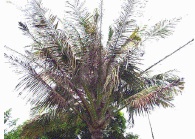Coconut Leaf Beetle pg.3

Palm with damage caused by beetle
Strategies to avoid further spread: Since the spread of the beetle is mainly through the movement of beetle-affected palms, all palms meant for transportation from known areas of infestation should be checked to make sure they are beetle-free. A simple inspection of the young leaves in the throat of the palm will be sufficient. To avoid further spread, non-infested countries in the region should adopt strict quarantine measures to control the import of plant materials, soil and any organic materials from infested countries. Potential spread through animals and human beings who can carry eggs, larvae or adults of the beetle on their bodies cannot be ruled out. Passengers traveling from beetle-infested countries should be encouraged to examine their baggage for the presence of the beetle/eggs/larvae. Countries such as India, Bangladesh and Sri Lanka, major coconut growers, are at high risk because neighboring countries including Myanmar and Maldives are already infested. Raising awareness and capacity building through training programs is essential to contain the problem. Countries already afflicted by the beetle may adopt intensive biocontrol programs to minimize losses due to attacks and to check the further spread of the beetle. FAO is helping countries that lack expertise in biological control to develop integrated pest management programs that suit each country’s unique environment. This support has assisted countries in identifying the coconut beetle to species level, in collecting and importing natural enemies of the beetle, rearing them in captivity for evaluation and releasing them in the wild.
Control: Mechanical- Blockading and cutting of coconut palms up to three kilometers from the infestation spot are done to prevent the beetle from spreading. The pest is also controlled by pruning, clean culture and proper disposal of infested coconut palms and parts thereof. Chemical – Several insecticides including imidacloprid, dieldrin, aldrin, phosdrin, aldicarb, dichlorvos, fenthion, monocrotophos, chlorfenvinfos, idiofenphos, trichlorophon, quinalphos, deltamethrin, dimethoate, cypermethrin, diazinon, azinophos, methidathion and chlordane are being used to control the coconut leaf beetle. Some insecticides are also injected in to the trunk of infested palms. However, the effect of these treatments lasts only for 3-4 months. Repeated applications may be impractical and uneconomic and cannot be used as a long-term control measure. In China, hanging insecticide bags on infested palms has been attempted successfully to check the spread of the beetle. Biological- Two parasitoids of coconut leaf beetle viz.,Tetrastichus brontispae and Asecodes hispinarum, have been successfully used in several countries to control the beetle. Use of the entomopathogenic fungus Metarrhizium anisopliae is also promising.
Page: 1 2 3
